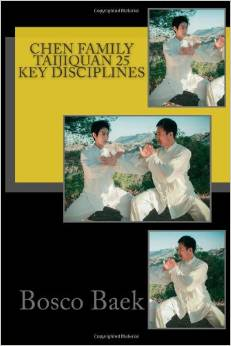6.b.xx.-25-key-disciplines-baek Section
Chen Family Taijiquan - 25 Key Disciplines
Paperback: 89 pages Author: Bosco Baek
Publisher: Chen Bing Taiji Academy (2014)
ISBN-13: 9781495927010 Reviewer: Nick Gudge (2014)
 This book was written by a disciple of Chen Bing. Written in Korean and then English, it is a book that addresses the theory of taijiquan using the translation and interpretation of key Chinese taijiquan teaching aphorisms (disciplines) within the body of traditional taijiquan training.
This book was written by a disciple of Chen Bing. Written in Korean and then English, it is a book that addresses the theory of taijiquan using the translation and interpretation of key Chinese taijiquan teaching aphorisms (disciplines) within the body of traditional taijiquan training.
These 25 disciplines, (perhaps easier to think of them as sayings or rules e.g. 'Quan Shen Fang Song,' translated as 'Relax the body deeply,' where disciplining the body and mind to follow them results in improving taijiquan skills,) are separated into four groups, with an introductory discourse on 'Fang Song'' These are titled 'What is Fang Song', 'The Law of Body,' 'The Law of Mind,' The Law of Reeling Silk' and '4 Major Characteristics.'
The author provides the saying or discipline in Chinese characters, with the appropriate trans-literation to pin yin. He gives a direct translation of each character, a 'Direct translation' meaning an overall translated meaning of the saying. Then he provides a 'Practical translation,' meaning his interpretation of the meaning of the saying rendered into useable English. Finally, in most cases, an 'Annotation' providing his interpretation of the saying. Some of the annotations are a paragraph long, some of them are several pages long.
I admire the approach utilised in this book and am grateful to the author for his introduction of some of the phrases and characters contained within it to the body of taijiquan theory in English. It is a valuable step towards (and of significant value to those who want to understand) the theory of taijiquan and how it relates to practice.
In my opinion the book suffers in three more significant ways and one less significant way. The more significant aspects are: first that the English is not very good. Some of it is quite funny. It could do with re-editing by someone who both understands these ideas and whose first language is English. (I understand the author is Korean, now living in the USA.) Second, that the translation of some of the characters and saying differs markedly from those I have from other sources, most noteably from Wang Hai Jun. The third significant aspects is the choice of teachings or disciplines. There are a few major elements central to taijiquan that are absent e.g. peng jing.
The less significant way this book suffers is that that there is no connection between the pieces within a section or between sections within the book: no method is used to connect the 'disciplines' together, even the ones that are related together in the same chapter. No cohesive effort is made to prioritise the disciplines. This makes reading the book a little like reading a dictionary. (This may have been the author's intent.) In this respect it is not well 'written,' and makes it both more difficult read and less helpful to beginners.
Ratings: Overall: 6.25 out of 10
Content: 7 out of 10 Language: 5 out of 10 Accuracy: 8 out of 10 Helpfulness: 5 out of 10
